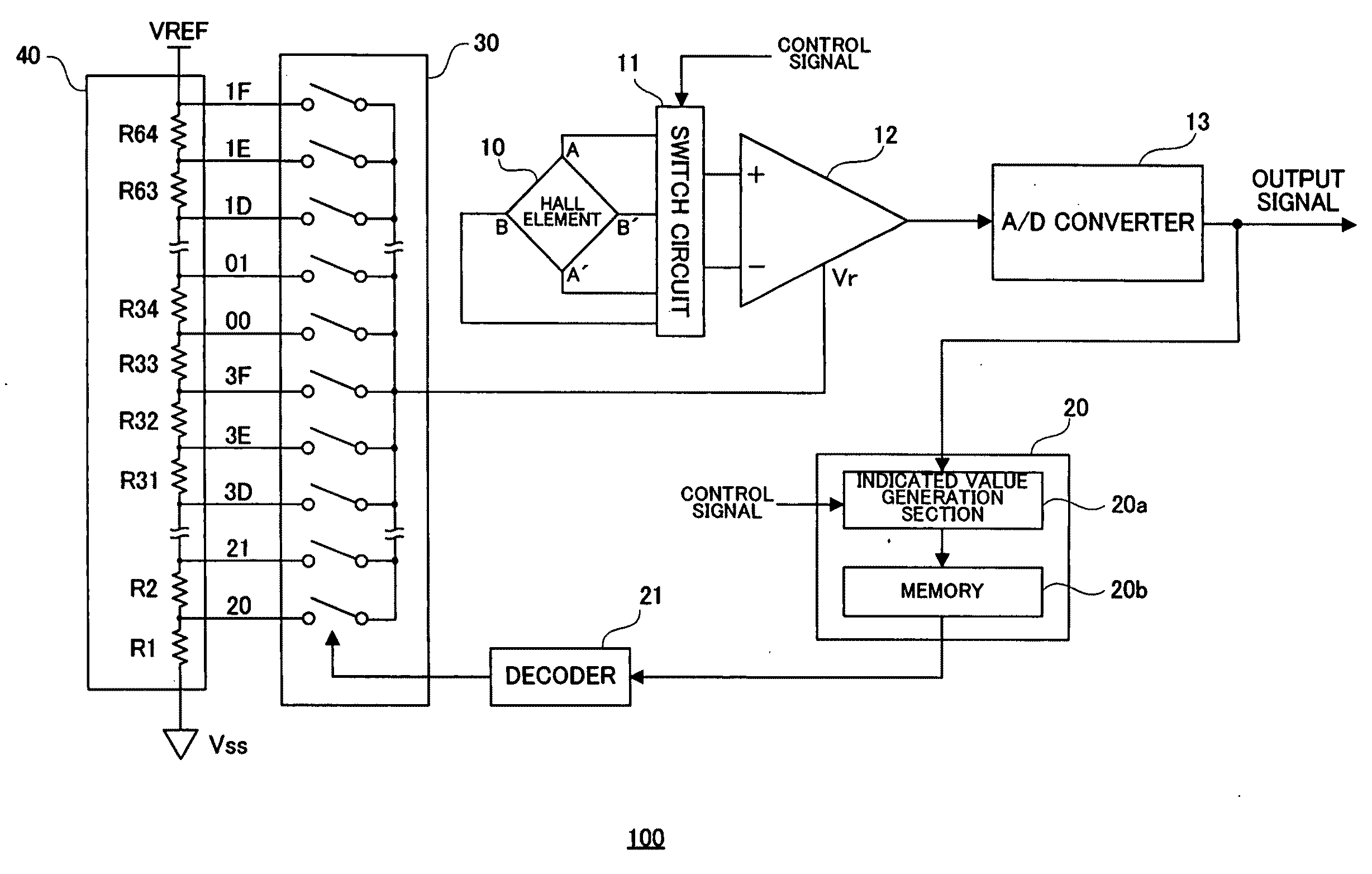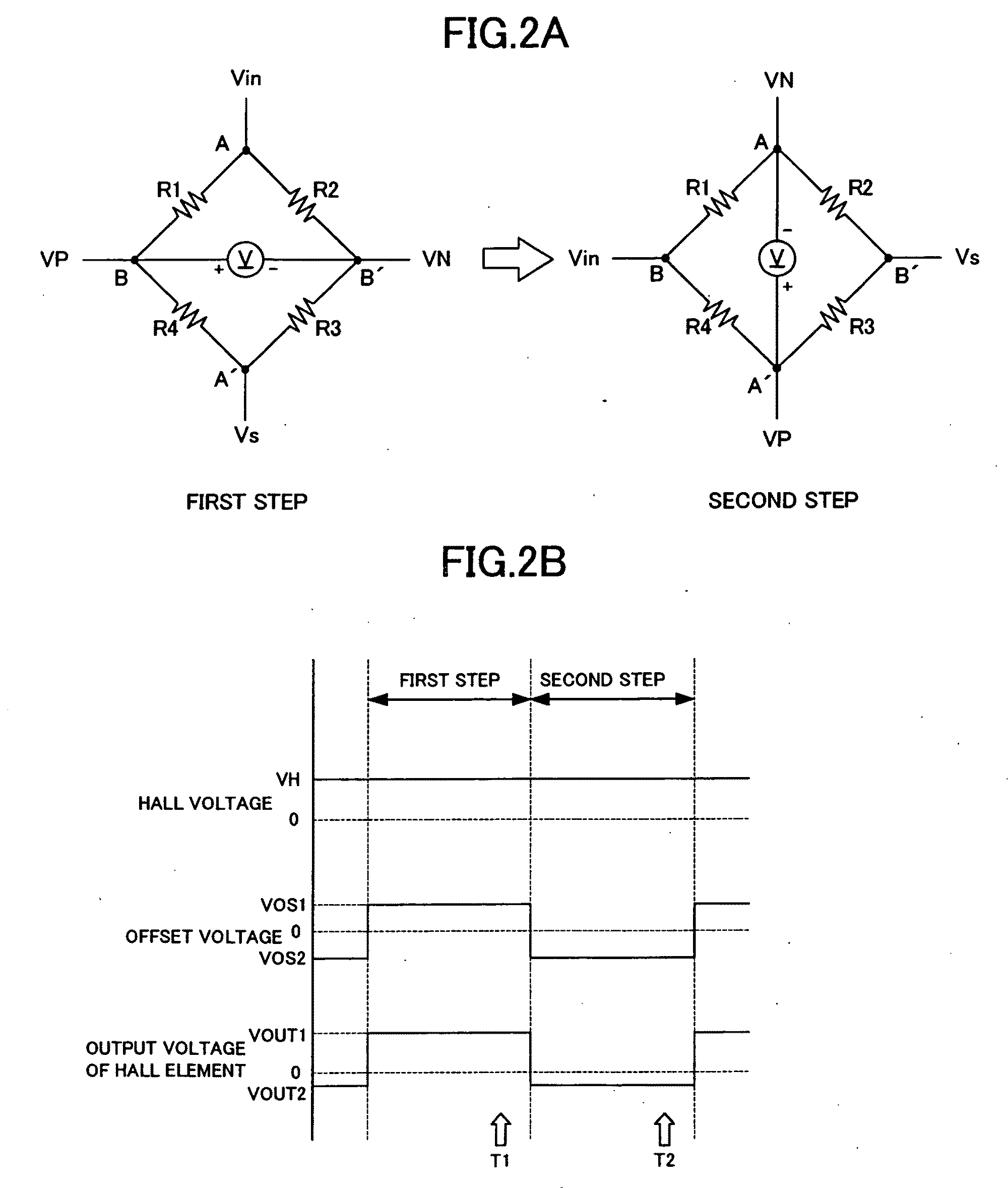Magneto-sensitive integrated circuit
a technology of integrated circuits and magnets, applied in the field of magneto-sensitive integrated circuits, can solve the problems of insufficient a/d conversion precision, inability to achieve sufficient magnetic field detection precision, and inability to fully increase the amplifier's gain, etc., to achieve high precision and increase the gain of the amplifier.
- Summary
- Abstract
- Description
- Claims
- Application Information
AI Technical Summary
Benefits of technology
Problems solved by technology
Method used
Image
Examples
first embodiment
[0029]FIG. 4 shows the configuration of a Hall IC 100 according to a first embodiment of the invention. The Hall IC 100 comprises a Hall element 10, a switch circuit 11, an amplifier 12, an A / D converter 13, a control circuit 20, a decoder 21, a selector 30 and a resistor ladder circuit 40.
[0030]The Hall element 10 is the well-known Hall element formed of a semiconductor thin film made of Si, and having four terminals of A, A′, B and B′.
[0031]The switch circuit 11 switches the connection between the amplifier 12 with a power source (not shown) for feeding electricity to the Hall element 10 and the Hall element 10 in accordance with a control signal supplied from the outside in detecting a magnetic field by a spinning current method. That is, the switch circuit 11, in accordance with the control signal, connects the power source (not shown) between the A-A′ terminals of the Hall element and connects the terminals B and B′ to a non-inverted input terminal and an inverted input termina...
second embodiment
[0051]In the Hall IC 100 of the first embodiment, because the offset voltages occurring at the first and second steps of the spinning current method have equal absolute values and mutually different polarities, to remove them, two reference voltage output terminals generating the voltages shifted by the same value in the positive and negative directions around 0.5*VREF are selected from among the reference voltage output terminals of the resistor ladder circuit 40, and the indicated values (e.g., 3Eh and 00h) corresponding to them are stored in the memory. That is, it is required that two indicated values are stored and read in measuring the magnetic field in the configuration of the first embodiment.
[0052]On the contrary, in a Hall IC 200 of the second embodiment, the magnetic field is measured with only one indicated value to reduce the memory capacity. Herein, if the indicated value is only “3Eh”, for example, it is required to output “00h” based on “3Eh”, in which after making t...
third embodiment
[0065]FIG. 9 is a graph showing the temperature characteristic of the offset voltage when the Hall element is driven at constant current. As shown in FIG. 9, the offset voltage contained in the Hall element output voltage has the temperature characteristic of a quadratic function, in which it is required to correct this to detect the magnetic field at high precision. A Hall IC 300 according to the third embodiment has means for correcting the temperature characteristic of the offset voltage for the Hall element.
[0066]FIG. 10 is a block diagram showing the configuration of the Hall IC 300 according to this embodiment. In the Hall IC 300 according to the third embodiment, the EEPROM 22 is replaced with a control circuit 50, as compared with the configuration of the second embodiment. The control circuit 50 comprises a temperature measurement section 51, a correction value generation section 52, the EEPROMs 53 and 54, and an adder 55.
[0067]The temperature measurement section51 comprise...
PUM
 Login to View More
Login to View More Abstract
Description
Claims
Application Information
 Login to View More
Login to View More - R&D
- Intellectual Property
- Life Sciences
- Materials
- Tech Scout
- Unparalleled Data Quality
- Higher Quality Content
- 60% Fewer Hallucinations
Browse by: Latest US Patents, China's latest patents, Technical Efficacy Thesaurus, Application Domain, Technology Topic, Popular Technical Reports.
© 2025 PatSnap. All rights reserved.Legal|Privacy policy|Modern Slavery Act Transparency Statement|Sitemap|About US| Contact US: help@patsnap.com



